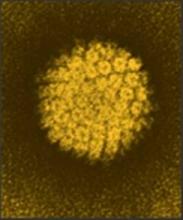Two doses of the human papillomavirus vaccine may be as effective as three in young adolescent girls, a postmarketing study suggests.
The immunogenic response of girls who got the two vaccines 6 months apart was just as good – if not better – than it was in girls and young women who had the traditional three-dose schedule, reported Dr. Simon R.M. Dobson and colleagues. The study was published in the May 1 issue of JAMA.
Longer and larger studies will be necessary before considering any change to the recommended regime, but an effective two-dose schedule could impart an enormous benefit in both developed and underdeveloped countries, Dr. Dobson said during a press briefing.
In Canada, about 40% of girls are not fully vaccinated; in the United States, that number reaches 80%, said Dr. Dobson of the University of British Columbia, Vancouver. Cost is probably part of the issue. A two-dose schedule could increase compliance considerably, he said.
In less-developed countries – including those without routine cervical cancer screening, where the need for protection is arguably greater – the HPV vaccine is less accessible. "The three-dose schedule might simply be out of range, but a two-dose schedule might make it accessible to many more women," he said.
This trial involved 830 subjects: 520 girls aged 9-13 years, who were randomized to a two- or three-dose schedule of the HPV quadrivalent vaccine, and 310 women aged 16-26 years, all of whom were vaccinated according to the three-dose schedule. The main endpoint was immunogenicity at 7 and up to 36 months after the last vaccine dose (JAMA 2013;309:1793-1802).
The mean titer antibody levels in girls who got the two-dose schedule were noninferior to those of the young women who had three doses: 7,344 mMU/mL for HPV-16 and 1,169 mMU/mL for HPV-18 vs. 3,545 mMU/mL for HPV-16 and 664 mMU/mL for HPV-18.
The investigators determined that the geometric mean titer ratios also were noninferior in the younger group compared with the older group: 2.07 for HPV-16 and 1.76 for HPV-18.
The results were similar for HPV-6 and HPV-11, Dr. Dobson and the coauthors reported. The younger girls who received doses had mean titer levels of 2,117 mMU/mL for HPV-6 and 2,339 for HPV-11, compared with 943 mMU/mL and 1,268 mMU/mL, respectively, for the women. The titer ratios also were noninferior.
The girls who received two doses also had noninferior GMT titers and ratios compared with girls who received three doses for all four vaccine genotypes. Girls receiving three doses had GMT levels of 7,736 for HPV-16, 1,730 for HPV-18, 1,876 for HPV-6, and 2,117 for HPV-11. Likewise, girls who received two doses vs. three doses had a noninferior antibody response for all four vaccine genotypes, with GMT ratios of 0.95 for HPV-16; 0.68 for HPV-18; 1.13 for HPV-6; and 1.10 for HPV-11.
Nearly all of the subjects (about 99%) remained seropositive for HPV-16, -6 and -11 until the end of the 36-month follow-up period.
At 24 months, HPV-18 seropositivity was seen in 89% of the girls who got two doses, 94% of the girls who got three doses, and 83% of the women who got three doses. This remained nearly unchanged for all three groups at 36 months.
Between 7 and 18 months, antibody levels for all four HPV genotypes declined and plateaued through the end of follow-up. "Both girls’ groups continued to maintain higher plateau levels of antibody at 36 months than women," Dr. Dobson said. However, there was some evidence that the two-dose group lost noninferiority for HPV-18 by 24 months, and HPV-6 by 36 months.
This finding does bring into question the durability of immune response in a two-dose vaccine schedule, Dr. Dobson said Antibody levels peaked at 7 months, then began to wane and plateaued at about 18 months, staying level until the end of the study. It’s still unclear how that waning level might impact protection; the same pattern is seen in young women who have gone through the entire three dose schedule.
"These young women have been followed for up to 10 years now, and the vaccine has remained 100% protective. There’s no magic antibody level below which we know protection fails. This vaccine is so good that there haven’t been enough vaccine failures to determine this," he said.
There’s already good evidence that societal protection is as important as individual protection, Dr. Dobson added at the press conference. "Studies in Australia [which has the largest vaccinated population] are showing protection from genital warts not only in women who are immunized, but in unimmunized men and unimmunized women as well. There’s a herd effect occurring – but we don’t know if two doses will have the same effect here as three doses do."


